This article was written by North Portland resident and member of the Smarter Bridge coalition, Matthew Denton. Mr. Denton shares his evaluation of the bicycle and pedestrian facilities that are being proposed as part of the $4.2 billion Columbia River Crossing project. It was first published on SmarterBridge.org and some edits have been made for clarity and readability.
What is being proposed?
The current proposal being advocated for the Columbia River Crossing (CRC) combines bicycle, pedestrian, and light rail on a single structure separate from the main highway bridge. The bicycle/pedestrian facility consists of a roughly 1.5 mile long, 14-16 foot wide path for both directions of travel, with bicycles and pedestrians mixed.
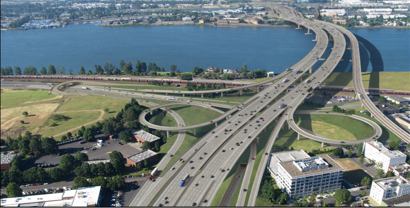
The bike and ped path would be accessible from a ramp near the Expo Center, a ramp in downtown Vancouver, (roughly a quarter mile north of the shore) and according to the plans, an elevator connection to Hayden Island, (shared with the transit station.) It would be very similar to the I-205 bridge pathway, in that one would have to climb a fairly long but not particularly steep hill in the act of crossing the bridge. Unlike on the I-205 bridge, one would not be riding between the two freeway sections, but instead next to a MAX trackway (probably separated by a fence, although current renderings don’t show that).
It will remind most people of a cattle chute much like the I-205 path. MAX trains would be running at 50+ mph, but at intervals, somewhat different from the continuous auto and truck traffic on I-205.
How is this better than what what we have now?
Crossing the Hayden Island interchange would no longer be an impediment, which is a major improvement, but the approaches at either end would be similar to what they are now: Vancouver’s would be quite good, connecting to Washington St. around 5th, although one will have to backtrack to get to the Vancouver waterfront.
The Portland MLK/Vancouver/Williams/West Marine Drive approach route would still involve a fair amount of out-of-directional travel to get to the ramp that then takes you up to the bridge level. While there are certainly aspects of that that are less than perfect, the proposed bicycle path is a major improvement over the current bicycle crossing. After all, the pathways on the existing bridge are only 4 feet wide.
“And that is the problem: The proposed bridge does help bicyclists while they are crossing the river, but the traffic from the freeway lanes will discourage bicycle usage in north Portland by clogging up the bicycle routes with cars and trucks.”
How is this worse than what we have now?
What isn’t mentioned anywhere in the Columbia River Crossing analysis is what the automobile traffic would be like on the other streets in the Portland area if this bridge is built.
For the morning rush hour, starting from the Vancouver side, most of the traffic would be on the freeways in Washington state, so a bicyclist wouldn’t encounter significantly more traffic than now. But since the bridge is 12 lanes (6 lanes in each direction) and 65% of the traffic that crosses the bridge southbound is heading to points south of Columbia Blvd, that means that there would be 4 lanes of traffic trying to go south on I-5 through North Portland.
I-5 is only 3 lanes there, so a full lane (2000 cars/hour or 1 car every 3 seconds) would have to get off the freeway and try to make their way south on the through streets like Vancouver, Interstate, Denver, and Greeley. Add in the vehicles that currently get on I-5 going south at rush hour (for instance, the semi-trucks that get on at the Columbia Blvd ramp) to that mix, and the result would be that using the bicycle lanes on Vancouver, Interstate, Denver, or Greeley at rush hour would be very similar to using the bicycle lane on SW Broadway: a lot of motor vehicle traffic, much of it in a hurry and trying to find a faster way through.
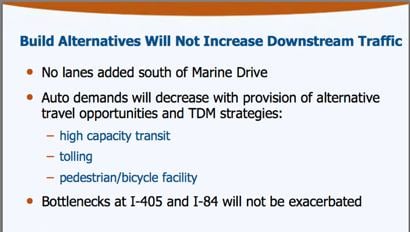
(Download complete presentation here (6.7MB PDF))
The official traffic estimates say that in 2030, slightly less traffic will go over the 12-lane bridge each day (assuming it has tolls and an adjacent transitway) than would cross the existing 6 lanes under the “no build” option (which assumes no transit, no tolling, no carbon taxes and gas prices back at 2006 levels). However, most of that traffic will be at rush hour. With the 12 lane bridge, for 5.5 hours a day, all 6 of the lanes in one direction or the other will be full, and they will then overflow onto the bicycle routes south of the bridge. With the current 6 lane bridge, 3 of the lanes in one direction or another will be full for 15 hours a day in 2030, (assuming the above,) but all that traffic will fit on I-5 though North Portland, and therefore will not spill onto the bicycle routes.
And that is the problem: The proposed bridge does help bicyclists while they are crossing the river, but the traffic from the freeway lanes will discourage bicycle usage in north Portland by clogging up the bicycle routes with cars and trucks.
How could smarter bridge alternatives provide better facilities?
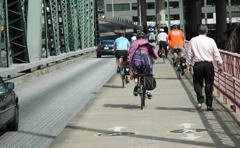
the Hawthorne bridge is often congested.
(Photo © J. Maus)
First of all, the proposed bi-directional, 14-16 foot wide section is not wide enough for a “world class” bicycle path.
For comparison, the smallest widths being proposed for the Sellwood Bridge replacement are 10 feet for each direction (20 feet total), although some are even wider and have separate lanes for bikes and pedestrians. Also keep in mind that the Hawthorne bridge bike path is 11 feet in each direction (22 feet total) and sees congestion at rush hour.
A smaller, smarter bridge that carries less traffic will reduce the off-bridge impacts described above. However, the bicycle facilities themselves could be far superior to what is being offered on the mega-bridge. The sheer length, the lack of easy connection to either river bank, and the lack of easy connection to Hayden Island are all caused by the scale and height of the proposed replacement bridge.
“A 12-lane freeway with a bicycle path has the same sort of ideological issues as putting a bike rack on a Hummer.”
Crossing this bridge would still be a good 1.25 mile ride, because the river is still fairly wide. Smaller scale alternatives would offer connections to the south and north Columbia riverfronts, as well as a ride (instead of an elevator) to Hayden island.
One smarter alternative moves the main shipping channel south, by fixing the railroad bridge, and retaining the current bridges for I-5. This means that a shorter, cheaper transit bridge can follow the profile of the current bridges, with a lift span still available for those very rare occasions (restricted to night time) when an oversized piece of equipment must be moved. This reduces the size of the hill in the middle of the bridge significantly.
Optionally, one or more non-freeway motor vehicle lanes could be attached to the transit-pedestrian-bicycle bridge. This would reduce the isolation that cyclists would experience in the Columbia River Crossing proposal, a cause of concern to some cyclists during late hours.
What are the ethics here?
Most people ride bicycles (besides the fact that riding a bicycle is fun) because they care about the environment: global warming; the amount of our landscape taken up by parking; peak oil; the obesity problems our population faces; and any number of other serious problems that bicycling helps.
As such, a 12 lane freeway with a bicycle path has the same sort of ideological issues as putting a bike rack on a Hummer. It is certainly better than a Hummer without a bike rack, but that doesn’t make it a good idea. Those 12 lanes of freeway add $3 billion to the cost of this project over the the smarter alternatives.
__________
Sources (from ColumbiaRiverCrossing.org):
- CRC Project Powerpoint Presentation to the Portland Planning Commission (presented March 11, 2008: 6.7 MB, PDF)
- Map/graphics: Downstream Replacement Bridge with bus rapid transit or light rail (3 MB, PDF)
- CRC Draft Concepts (7.8 MB, PDF)
- CRC Pedestrian and Bicycle Fact Sheet (512 kb, PDF)
- Pedestrian and Bicycle Advisory Committee Working Documents (1.8 MB, PDF)
For more information on the CRC project visit ColumbiaRiverCrossing.org, SmarterBridge.org, or browse my previous coverage.
You can also attend the BTA’s “members-only” forum on the CRC tomorrow. Details here.


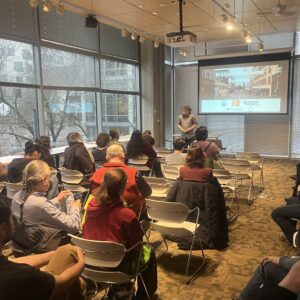
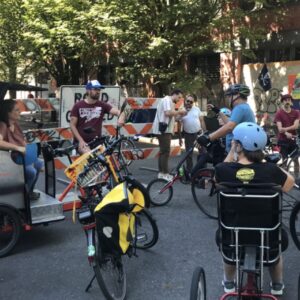
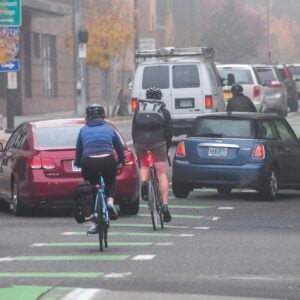

Thanks for reading.
BikePortland has served this community with independent community journalism since 2005. We rely on subscriptions from readers like you to survive. Your financial support is vital in keeping this valuable resource alive and well.
Please subscribe today to strengthen and expand our work.
Great article. Thanks for sharing it with us, Jonathan. I\’ll have to look through it again. That\’s a lot to digest.
Obviously the \”Smarterbridge\” folks don\’t like anything about the bridge project, and the article seems to contradict a lot of the work that is being done by the CRC committee to develop a world-class path. Is Matt on the committee or has he attended any of the public workshops were they\’ve been designing the path?
IMO, people ride bicycles because they are fun, good exercise and cheap. The other reasons are a far distant fourth for the typical rider. If bikes weren\’t fun and cheap, no amount of good will towards the planet, etc would get them riding. Discussing what individuals want to do and what a society wants to do are two very different things.
If we want fewer people to drive over the bridge, we need congestion. Inconvenience and expense are the only viable ways to convert drivers to cyclists (albeit initially reluctant cyclists). Anything that streamlines the flow of traffic over the Columbia will increase traffic over the Columbia (that goes for both kinds of traffic, motorized and non-motorized).
Regardless of why Americans ride bikes today or yesterday, the number one motivation of the future will be economic.
Gas prices will continue to rise and this will force people who may not have considered cycling a valid transportation choice in the past to re-evaluate their position. It\’s begining to happen with $3 gas, by the time we hit $5 many wheels will be in motion.
Thanks for sharing and giving more options Mr. Denton.
I pimp bike infrastructure often, but I would rather noting be built than the peanuts the CRC is currently throwing us bikers.
How about expanding the Carpool lane to 2 of the 3 lanes? They could an exception for interstate freight.
I am just one of many people who will not tolerate any more waste on this project.
#2: The CRC is currently proposing the minimum legally required path. The pedestrian and bicycle group is trying to get it widened and designed better, (and don\’t get me wrong, I am very glad that they are doing that,) but they are facing a very tough battle. In any case, the smallest bridge that the group studied outside of the US was 24 feet, so we can\’t exactly call it \”world class\” until we\’ve gotten there…
That said, even if they made it 41 feet wide, (the widest total option that the Sellwood bridge group is considering,) and installed AC on it (like they do in some countries,) that doesn\’t change the problem that a whole lot of cars are going to be looking for a north/south route though north Portland at rush hour, and are going to find it on the streets that we\’re currently riding on…
(And yes, I\’ve been to quite a few CRC meetings, but I am not on any official CRC group.)
As for the path width issue. … The CRC\’s Bike and Ped guy, David Parisi has said repeatedly that the reason they\’re looking at a 14-16 foot, bi-directional path is because that\’s \”what the FHWA will fund.\” The reasoning is that the FHWA only funds a bike/ped path to the standard width as designated by guidelines set forth in the all-important AASHTO book (American Assoc. of State Highways and Transportation Officials).
We can\’t let this be decided by what the standards call for. Everyone knows that American design standards for bike and ped facilities are woefully inadequate…. just like PDOT has done with the bike boxes … it\’s time to say goodbye to those national guidelines as long as they are constricting our ability to move forward and create the type of facilities that new traffic patterns (and our ailing planet) demand.
Keep up the good work. However…
Another \”smarter alternative\” is not to build the bridge. The bridge industry\’s propaganda hasn\’t conviced me that we need a new bridge yet. I hope I get to vote on this one.
There are streets in Portland that are 16 feet wide. That is probably twice as wide as the Springwater Corridor.
Have they thought about suspending the bike/ped path below the bridge. This does a couple of things:
1. width is less of an issue
2. Covered path would be great in the winter
3. Shielded from highway roar
Difficulty would be in reduced shipping clearance.
#10
Those must be some old streets, currently the city mandates a minimum of 20 foot wide streets when no parking is allowed, wider if there is parking. I\’m sure there probably is some old one way street that is 16\’ wide somewhere in the city, but it would be a rarity. 16\’ would certainly be better than what the 205 bridge has right now, where I regularly worry about crashing into someone coming the other way, but it wouldn\’t exactly be overkill.
\”I-5 is only 3 lanes there, so a full lane (2000 cars/hour or 1 car every 3 seconds) would have to get off the freeway and try to make their way south on the through streets like Vancouver, Interstate, Denver, and Greeley.\”
I don\’t follow this logic. 4 lanes narrowing to 3 means that 25% of southbound traffic would exit and clog the bike routes in N. Portland? More likely the current bottleneck would be exacerbated, despite what the CRC slide says. I appreciate is Mr. Denton\’s thoughts, but I hope this not his strongest appeal to cyclists in opposition to the bridge. I\’m not sure where I stand, but this hasn\’t swayed me one way or the other.
Thanks Jonathan… this is great information to share.
Mathew does an excellent job of going beyond the discussion of facility width to detail how super highway bridge is completely incompatible with the human scale connections (for bikes and peds) we need in a new Columbia River Crossing. We are not just connecting two states or even two cities… we are connecting neighborhoods historically divided and diminished by a freeway. It should be as easy and safe to bike to downtown Vancouver from North Portland bike to downtown Portland.
Jim
So–it won\’t really improve the Delta Park clusterfuck, will it?
Very interesting. As a daily Hawthorne Bridge commuter — and one who remembers what it was like before the sidewalks were widened — I must agree that a 14-16 foot wide bi-directional shared path is hardly wide enough to begin with, and downright short-sighted for the long term.
We\’re starting to get bike congestion in Portland (hooray!), so if the bridge is being planned for the long term, shouldn\’t it accommodate future cyclists in the same way that it would accommodate future motorized vehicles?
Say — I remember Roger Geller talking about how the Bicycle Master Plan will include standards for bicycle design because the existing standards are so inadequate…might off-street path widths be included in it? If so, might that be an opportunity for revisiting the bridge design?
The AASHTO guidelines have an underlying assumption that a path won\’t see high volumes of cyclists. Those guidelines really need to be refined to be based on capacity.
Those six traffic lanes in each direction, come 2030, are going to look mighty empty, what with $18/gallon motor fuel and the bulk of interstate freight traveling by rail. But they\’ll make great bike lanes, won\’t they?
So, how much bicycle and pedestrian traffic are you predicting on a new Columbia River bridge? I suppose it would be more than on the I-205 bridge, because it should be a nicer facility and closer to population centers. Are you expecting the volumes to be similar to the Hawthorne Bridge today? I find the Hawthorne Bridge, which I ride daily, to be crowded only during the noon hour or on really nice weekends, and that\’s due to lots of pedestrians? Would you expect that level of pedestrian activity, too?
#11: They are looking at that:
http://bikeportland.org/2008/01/21/new-i-5-bridge-whats-in-store-for-bikes/
#15: The Delta Park mess is \”cleaner\” in that there aren\’t all the weird turns in it as you cross the interchange, but the bike bridge is over by the Expo Center MAX station, so unless you are coming from the west side of the I-5, it won\’t save you much time over the current mess. (It will be great if you are trying to get on the bridge to/from the Expo Center.)
#13: Yes, you are right, it isn\’t that simple. 25% of the cars don\’t get off I-5 just because it will be 25% narrower. The cars will stay on I-5 and cause congestion there until the freeway is as slow as the alternative routes. It is any traffic beyond that level that will get off, (until the alternative routes slow down to the level of the freeway.)
The CRC estimates the rush hour travel times from SR-500 to Columbia Blvd (5 miles) as 29 minutes regardless of if they build this thing or not, 300k PDF, see second graph on page 37 so traffic across the bridge will be going on average 10 mph for all 6 lanes when it crosses the Oregon border. 35% of that gets off before Columbia Blvd, leaving the other 65%, or about 4 lanes worth looking to get through north Portland.
If only 25% of the remaining traffic gets off before Columbia, then traffic on I-5 will still be going 10 mph. If more than 25% gets off then traffic speeds on the freeway will increase, and if less than 25% get off, then it will decrease…
Given that Vancouver/Williams is signed and signaled for 30 mph. Interstate is signed for 30 mph, but not signaled for it, and Greeley only has a few signals on it, but has a high speed portion of 45, (the traffic also will go down other streets too: MLK is the big one, 30 mph, I think?) then there is an incentive for more than 25% of the traffic to get off of I-5, (assuming that that traffic doesn\’t slow down all the arteries in north Portland to 10 mph…)
Now, I\’ll admit that that is a simplification as well, (since I don\’t know exactly where the bottleneck is on the CRC bridge after they build it, so it could be 15 mph speeds after the bridge,) but the point is the same as long as the freeway speeds aren\’t above 25 mph on the 3 lane section through north Portland, there is an incentive for people to get off the freeway and get on the arteries that we are trying to ride our bicycles on.
(And 10 mph? I ride up the steep part of the hill on Interstate at that speed and I normally get passed by other bicyclists while I\’m doing it. We should be able to convince more of the Clark County Commuters to bicycle.)
Here\’s a more realisitc rendering of a Columbia River Crossing
http://www.yourbodypower.org/CRC-realistic.jpg
What happened to the concept of putting the transit lanes inside the girders, below the vehicle lanes, and having the bike/ped path(s) below the road, adjacent to the transit? Several months ago, I heard this was the recommendation of the third-party value engineering study and that it was being forwarded at the preferred configuration (pending FHWA/FTA approval).
It seems to me that a second bridge for transit/bike/ped would increase the costs and permitting nightmares, as well as (shudder) making it easier to cut if costs for the highway structure become too high.
Aaron\’s (21) improved view of the Vancouver approach says what needs to be said: a monstrosity in every respect!
I have asked a Vancouver user what she and her family think. Worst aspects of the present–narrow sidewalk and booms from the bird cannons. Best aspect–bikes still move faster than cars at peak hours. First choice alternative–a ferry for peds and bikes!
Robert Liberty and Metro–which probably will become our local bridge authority–strongly favor \”skinny bridges\” for Sellwood and CRC. Why do we get these stupendous \”planning\” exercises that inevitably lead to the most dysfunctional, expensive, delayed, and plain ugly solutions? Those guys just want to pave the world!
David Steinman and Conde McCullough are turning over in their graves.
Robert Liberty is leading the oppostion to this monster, the $4.2 Billion CRC. If you don\’t believe me, see last Friday\’s Portland Tribune.
Opponents are calling for an arterial bridge for local traffic, light rail and true world class bike/ped facilities more in line with some recently posted pics from Europe.
Maybe we should call it a \”frontage road\” bridge, so the DOTs can bring themselves to build it and remove some substandard on/off ramps that screw up that section of I-5.
\”Keep up the good work. However…
Another \”smarter alternative\” is not to build the bridge. The bridge industry\’s propaganda hasn\’t conviced me that we need a new bridge yet. I hope I get to vote on this one.\”
You do know that the current I-5 bridge is the largest bottleneck for all of I-5, from Canada to Mexico? All those nice shiny bike parts that you get come from *gasp* 18 wheelers that ship them here. The delays they go through on I-5 here in Portland cost companies 10s of millions of dollars every year, increasing the cost of your shiny bike new bike parts. Motorized vehicles are bad, blah blah blah, but when it comes down to it you depend up on them for most of the things you consume.
\”All those nice shiny bike parts that you get come from *gasp* 18 wheelers that ship them here.\” AllOver
Right, AllOver, I imagine a lot of people understand that, but 18 wheelers aren\’t the ones clogging up the bottleneck. That distinction belongs to hundreds of thousands of single occupancy vehicles going through it morning and late afternoon. So, just figure out a way to limit a lot of them from being on the current bridge, and $4.2 billion is …saved!
allover, you bring up a good point. YOur point of course that we all need to consume less was well taken. It\’s like when people remodel their house to make more storage space. You don\’t need more storage space, you need less stuff. It\’s the same with the bridge. We don\’t need a bigger bridge, we need less drivers. Holy cow do we need less drivers. What if we took the same amount of money that they plan to spend on this project and dumped it into a serious (billions of dollars would be pretty damn serious) campaign to reduce traffic and consumption? Maybe buy everybody REALLY nice commuter bikes and pay them a per diem to ride them. With that amount of money, we probably could do it. What if?
We need to take a close look to make sure the coming draft Environment Impact Statement (EIS) actually considers the full health effects of a new bridge. For example, is the increased injury risk for cyclists and pedestrians in North Portland factored in?
The National Environmental Policy Act of 1969 (NEPA) requires not only consideration of human health effects (including being run over, noise and air pollution), but it also specifically requires extra attention to low-income or minority neighborhoods. So the CRC report must take a close look at the impact on North Portland.
And as for the current bridge being the biggest bottleneck on I-5 between Canada and Mexico… isn\’t that what I-205 was supposed to remedy? Why would long-haul traffic use the I-5 bridge, unless it isn\’t really that bad? Are we just supposed to keep throwing money at new bridge lanes?
Think what even half the CRC budget, a couple of billion dollars, could do for revamping rail lines to shift freight and long-distance travelers to trains, thus relieving congestion all along I-5, not just a couple of miles of it.
#11: Remember this story? So you\’re asking me to choose between (a) having the roar of traffic, or (b) having a nice sheltered out of sight bike path for all sorts of sketchy characters to hang out in. Hmmmm. I think I\’ll go with (a). It\’s not going to be that much quieter under the bridge.
Gossip says Rex Burkholder is actively working to position himself to replace Metro Council President David Bragdon when Bragdon leaves.
Burkholder, of course, is one of the BTA\’s founders and remains a staunch bicyclist. Remarkably, he\’s also a champion for this massive abomination.
Prediction: his continued support for this project is going to erode his progressive base. He\’s making himself an easy and accurate target to claims of \”sell out.\” At $4.2 BILLION, that\’s pun intended. There\’s no way this project in its current incarnation can be defended. Politically speaking, Rex will be haunted by this decision.
\”More than 50% of trucks entering the region don\’t stop inside the region. The I-5 corridor is the route for 60% of the region\’s pass-through trips. Of trucks entering/leaving the region, 20% were empty.\” This is Cambridge Systematics\’ \”Portland Freight Data Collection\” presented to Metro\’s TPAC on April 27, 2007.
Now you know why you see fully loaded log trucks on I-5 in the middle of the day…its the fastest, most direct route, the Interstate Bridges notwithstanding. The sky is not falling.
Todd Boulanger put up some photos of wonderful bike/motor vehicle/transit bridges in Europe…Take another look at them. They are all models for the low cost \”arterial or frontage road\” bridge that those of us opposed to the CRC\’s monster bridge propose…24\’ plus bike/ped promanade, two traffic lanes for local trips and light rail.
Remove substandard on/off ramps from I-5; retrofit the bridge to current seismic standards and fix the RR bridge and we are done…all paid for with tolls on I-5 and I-205.